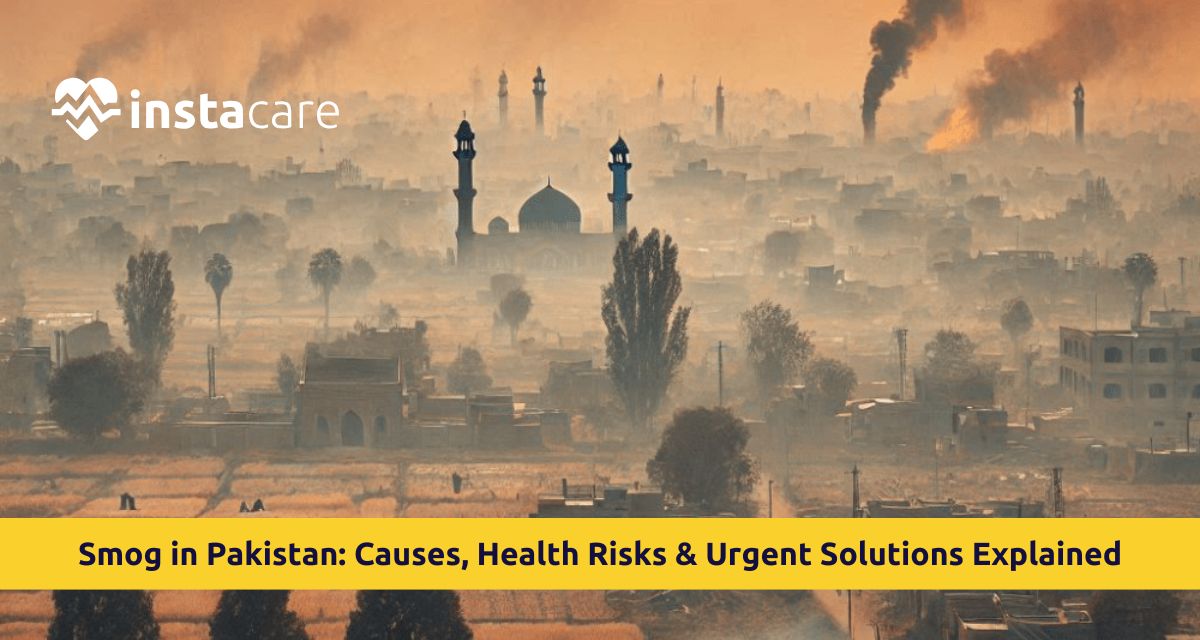Smog is one of the highest forms of environmental pollution in Pakistan. Every year, especially during winter, cities like Lahore, Faisalabad, Karachi, and Gujranwala face heavy pollution. Smoke mixed with fog reduces visibility, disrupts daily life, yet poses serious health risks. Understanding the main smog causes along with medical concerns, harm to nature, or feasible responses is essential to safeguard citizens plus guide future policy.
What is Smog?
Smog forms if vehicle exhaust, industrial emissions, or agricultural smoke mix with humid air. In chilly conditions, pollution tends to stay low, building up as a thick haze above urban areas. Regions that have heavy industry, widespread burning in fields, or high traffic see it happen more often. Air pollution in Pakistan often exceeds international safety levels, on some days by a wide margin. Consequently, millions are at risk; air quality ranks as one of the country's most urgent public health challenges today.
Causes of Smog in Pakistan
Pakistan's smog stems from various human activities alongside weather patterns. One key cause involves emissions from vehicles, while industrial output plays a major role. Agricultural burning adds to the issue, whereas seasonal temperature shifts worsen air quality. Urban expansion contributes significantly, though natural wind flow changes also matter.
1. Vehicle Emissions
Rapid urban expansion fills roads with vehicles like cars, bikes, buses, also freight lorries. Since many aren't properly maintained, they release excess carbon monoxide as well as nitrogen dioxide into the air. Tiny dangerous particles come out too, mainly from older or poorly serviced engines.
2. Industrial Pollution
Factories such as brick ovens or metal plants release dirty fumes without cleaning them. These discharges mix with damp air, greatly contributing to fog-like pollution.
3. Crop Burning
Farmers burning leftover crops in Punjab create dense smoke that drifts into cities. Because this repeats annually, it strongly adds to severe smog throughout Pakistan.
4. Construction and Dust
Construction without oversight emits particles, worsening air purity. In rapidly expanding cities, particle pollution stays common.
5. Climate and Weather Conditions
Cold winter traps polluted air near the surface, preventing dispersion. In absence of rain, contaminants accumulate gradually, due to limited clearance. Understanding smog season in Pakistan helps predict high-risk periods.
6. Use of Low-Quality Fuel
Fuel of poor quality contains higher levels of sulfur, which results in more smoke accumulating in the atmosphere. However, pollution increases significantly when specific factors are present.
Together, these factors explain most of today's nationwide smog. While some play smaller roles, they add up significantly. Still, pollution remains the core issue driving poor air quality everywhere.
Understand the Health Hazards of Smog in Pakistan
Smog is more dangerous than it seems. Long-term exposure can damage your lungs, at the same time weakening heart function. The smog effects on health are severe and widespread.
1. Respiratory Problems
Smoke irritates lung tissue plus airways, causing breath difficulties. People often experience persistent coughs; also, whistling sounds when inhaling, throat discomfort, nasal congestion, or pressure in the upper chest. The connection between smog and respiratory diseases continues to strengthen with each passing year.
2. Asthma and Allergies
Individuals with asthma tend to experience severe episodes more frequently; meanwhile, smog triggers allergic reactions year-round, making management harder.
3. Heart Diseases
Fine dust from fog enters the bloodstream, therefore, it might lead to heart issues or increase hypertension; irregular beats could occur as well.
4. Eye and Skin Irritation
Many people report burning eyes, itching, redness, and skin sensitivity during smog season.
5. Risk for Children and Elderly
Kids or elderly folks, especially those managing health problems, face higher risks. Due to air pollution, emergency room visits spike noticeably in this group.
Typically, pollution greatly affects well-being, also increasing respiratory conditions across the country.
Environmental Impact of Smog in Pakistan
Smog affects humans, it impacts wildlife as well, causing damage to agriculture as a result of deteriorating structures.
1. Reduced Visibility
Fog causes accidents on roads, delayed planes, shut classrooms, while disrupting daily life too.
2. Damage to Crops
Pollutants interfere with photosynthesis; as a result, crops grow slower yet yield less during harvest.
3. Acid Rain
Polluted air mixes with moisture, this leads to acid rain, which damages soil, plants, buildings, or aquatic systems.
4. Harm to Wildlife
Birds may struggle to breathe when smog alters their habitat, meanwhile meals grow harder to find due to these changes.
5. Overall Air Quality Decline
Smog heavily pollutes Pakistan's air, getting worse each year as emissions climb. Although actions are taken, results lag since measures face delays from poor oversight or insufficient funding.
Government Measures for Smog
Federal agencies together with regional bodies introduced different actions aimed at cutting haze, however actual implementation remains challenging. These government policies on smog in Pakistan reflect growing awareness of the crisis.
1. Smog Alerts & Emergency Plans
Authorities issue alerts when air quality worsens, on some days, outdoor access gets restricted.
2. Closing Schools Temporarily
To protect children, schools close during high pollution levels, using safety measures when air quality drops.
3. Vehicle and Fuel Regulation
Actions include promoting Euro-5 fuel; checking emissions by halting vehicles with noticeable fumes. These smog control measures aim to reduce vehicular pollution.
4. Industrial Monitoring
Some industries need technology to cut pollution, yet compliance varies across regions.
5. Crackdown on Crop Burning
Government agencies recommend alternatives to field burning for farmers, offering various methods. Officials encourage shifting from open flames through practical solutions. Authorities promote safer practices rather than ignition techniques.
6. Plantation Drives
Tree planting removes pollutants, also improving air quality.
These steps show what authorities are now doing about smog in Pakistan, though effective execution is crucial to achieve real results.
Read More: The History Of Smog In Lahore How Did It Become Such A Big Problem
How Individuals Can Protect Themselves from Smog?
Even though it takes work, individual steps count in fighting smog. For reduced risks, follow these smog prevention tips, one action builds protection; little decisions combine. Knowing the situation lets you respond sooner; being ready has impact. Let pollution updates guide daily plans; slight shifts create gains. Safe breathing begins with attention, basic behaviors lead to improved results.
1. Wear Anti-Pollution Masks
N95 or KN95 masks filter harmful particles and protect your lungs.
2. Stay Indoors on High-Smoke Days
Remain inside frequently, especially at sunrise or later in the evening.
3. Use Air Purifiers
Indoor air purifiers reduce contamination inside homes or offices, using filters that capture harmful particles from the environment while improving overall breathing conditions gradually over time.
4. Keep Windows Closed
Keep unclean air from entering your space.
5. Increase Fluid Intake
Fluids flush out toxins while maintaining hydration levels.
6. Eat Immune-Boosting Foods
Fruit or vegetables, along with balanced meals rich in nutrients, help strengthen your body's defense against pollution.
7. Avoid High-Traffic Routes
Select routes with less pollution whenever possible, choose greener options where offered.
8. Report Smoke-Emitting Vehicles
Citizens could assist in lowering air pollution in Pakistan by reporting violations, using simple actions that make a difference when shared widely.
Such steps back wider moves to cut emissions, at the same time encouraging thoughtful routines.
Conclusion
Smog in Pakistan is now harming both humans and the environment. Car emissions, industrial waste, crop burning, or poor-quality fuel are making air conditions worse over time. These cause lung problems, heart diseases, also long-term damage to natural systems.
Even though officials have begun taking steps through smog control measures, stronger monitoring combined with cooperation between different areas is still needed. Individuals ought to take action now in order to remain protected while reducing behaviors that worsen the situation. Through joint effort, meaningful change can emerge in Pakistan's struggle with polluted air, paving the way for improved well-being down the line.
Book an appointment with the best Pulmonologist in Lahore, Karachi, Islamabad, and other major cities through InstaCare. You can also call 0317-1777509 to connect with a verified doctor. Use the button below to book now.

